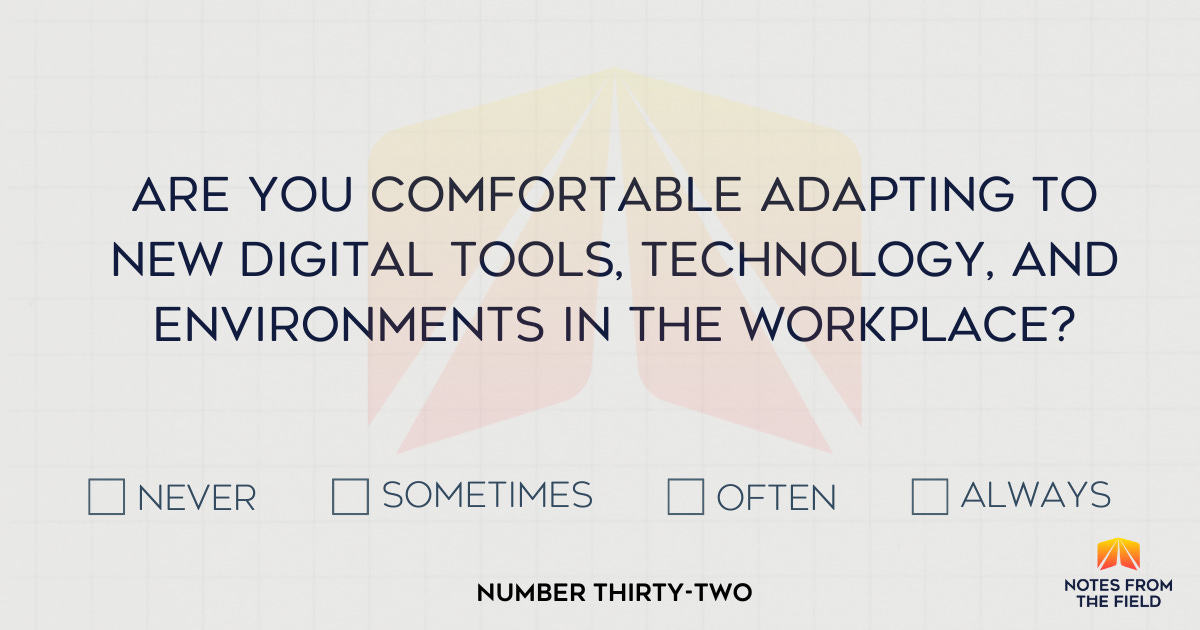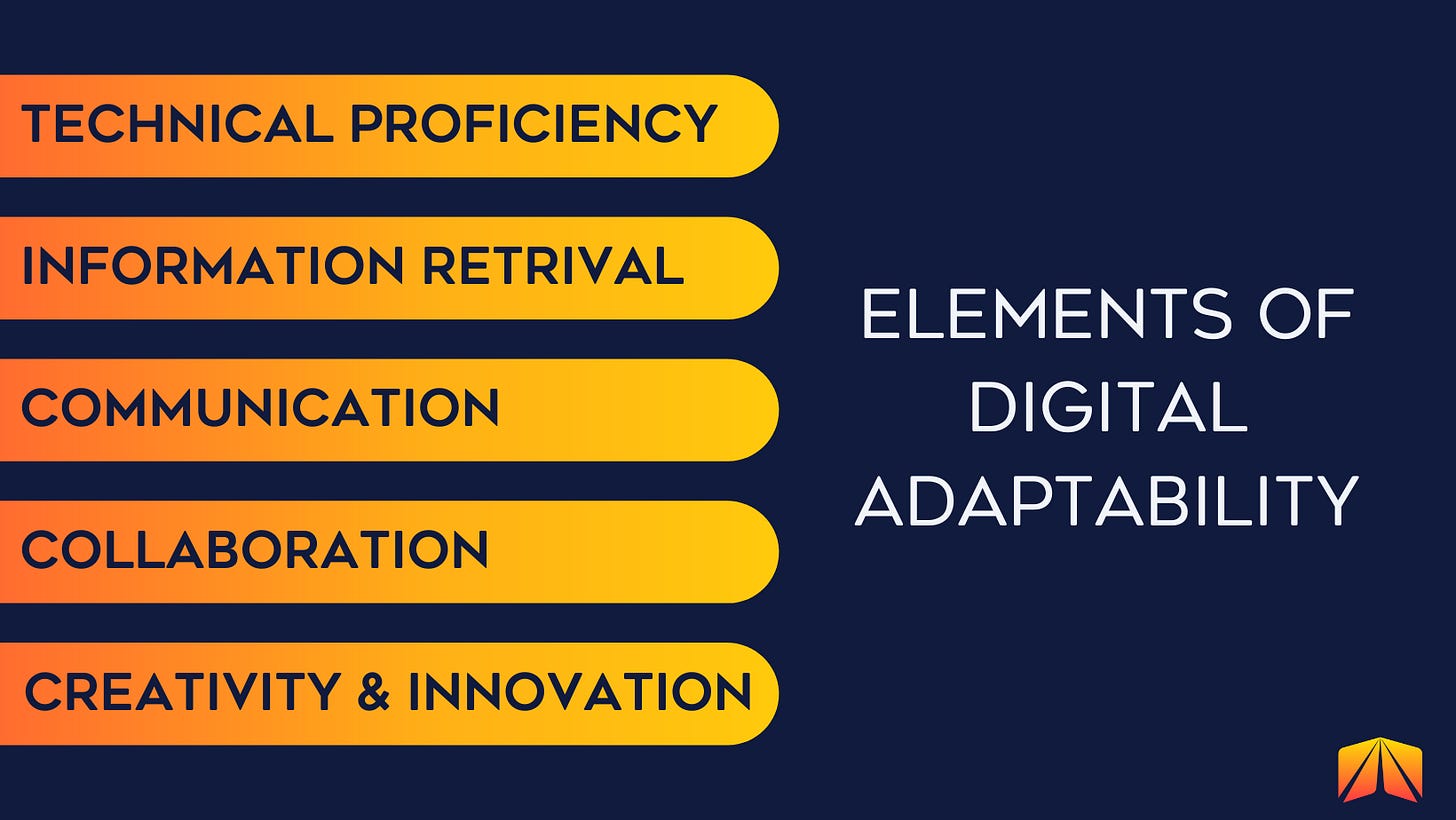On Soft Skills: Digital Adaptability
In the digital world, the only constant is change.
The continuation of our Soft Skill series. Catch up on other Soft Skill articles here.
In today's rapidly evolving digital landscape, the ability to adapt to new technologies and online environments is more crucial than ever. This skill, commonly referred to as digital adaptability, goes beyond basic computer literacy and encompasses the mindset and behaviors needed to thrive in a constantly changing digital world.
An Introduction to Digital Adaptability
Digital adaptability is the ability to navigate, evaluate, and synthesize information effectively using a range of digital tools. It encompasses a broad set of skills, from basic computer use to more complex abilities such as coding, online communication, and data analysis.
Digital adaptability is not just about being able to use the latest social media platform or software - it's about being open-minded, curious, and willing to continuously learn and improve. It's also about understanding how technology impacts our daily lives and having the ability to navigate its ever-changing landscape with confidence.
In today's digital age, being digitally adaptable ensures individuals are up to date with the constantly evolving technology landscape - and also enables them to effectively utilize digital tools for various tasks and projects.
The Importance of Digital Adaptability
In a world where technology is rapidly advancing, the ability to adapt and learn new digital skills is crucial. As industries evolve and become more digitized, employees are expected to have basic digital literacy skills and be able to quickly adapt to new technologies. This makes digital adaptability a highly sought-after soft skill in the job market.
Moreover, with the rise of remote work and virtual collaboration, being digitally adaptable has become even more important. People who can learn and use digital tools and platforms to communicate, collaborate, and complete tasks are highly valued. They can navigate the challenges of work environments and expectations while maintaining productivity, making them valuable assets to any team or organization.
Elements of Digital Adaptability
The components of digital adaptability contribute to the effectiveness in utilizing technology and reflect readiness to embrace ongoing changes in the digital realm. The core elements include:
Technical Proficiency
Technical proficiency refers to the foundational knowledge and skills necessary to effectively use digital tools and platforms. This encompasses a variety of competencies, including mastering software applications, understanding hardware components, and navigating various operating systems. People with strong technical proficiency can troubleshoot common issues, maintain devices, and optimize their digital environment for enhanced productivity.
In addition, technical proficiency allows for seamless adaptation to new technologies, as individuals quickly learn and integrate unfamiliar tools into their workflows to increase efficiency and minimize downtime. With the rapid pace of technological advancement - and the rapid pace of change in professional environments - developing and maintaining technical proficiency is essential for success.
Basic Skills: Understanding how to use digital devices (computers, smartphones, tablets), software applications (word processors, spreadsheets, presentation tools), and internet navigation
Advanced Skills: Knowledge of coding, programming languages, and using specialized software for tasks such as graphic design, video editing, and data analysis
Information Retrieval
Information retrieval is a vital aspect of digital adaptability, enabling a person to locate and evaluate pertinent information in a digital landscape saturated with data. This skill involves not only the ability to conduct effective online searches but also the discernment needed to assess the credibility and relevance of sources and the ability to apply this information in a responsible way.
In an age where misinformation can spread rapidly, strong information retrieval skills helps informed decision-making, positions arguments with credible data, and stays current with industry trends.
Mastering this skill empowers professionals to save time, enhance their problem-solving capabilities, and produce higher-quality work by leveraging accurate and reliable information. Furthermore, as the volume of digital content continues to grow, individuals who excel in information retrieval will stand out as valuable assets in any organization - simply because these people can find, evaluate, and present anything in the organizational knowledge base.
Finding Information: The ability to effectively search for, locate, and retrieve digital information
Evaluating Information: Assessing the credibility, relevance, and accuracy of digital information
Using Information: Applying information ethically and legally in various contexts
Communication and Collaboration
The world of work has changed significantly over the past twenty years. Digital communication and collaboration tools are now essential components of digital adaptability, enabling individuals and teams to interact effectively in a variety of environments, including remote, hybrid, and in-person presence, across time zones and borders, and even among different languages.
Mastery of platforms such as email, instant messaging, video conferencing, and project management software allows team members to share ideas, provide feedback, and coordinate efforts seamlessly. Proficiency in these tools facilitates clear and timely communication and fosters a collaborative culture where diverse perspectives can come together to solve problems, address issues, and make an impact.
As organizations increasingly rely on digital platforms to maintain productivity and connectivity, individuals who can adeptly navigate these tools - while also building their in-person skills - will enhance their contributions and ensure that teams are aligned toward shared goals.
Digital Communication: Proficiency in using email, social media, and other online communication tools to share information and collaborate with others.
Collaboration Tools: Using digital platforms such as Google Workspace, Microsoft Teams, and Slack to work collaboratively with teams.
Creativity and Innovation
Creative expression and innovation are pivotal components of digital adaptability, empowering individuals to create or build new methods to express ideas, insights, and innovation.
With the rise of various creative tools and platforms, such as digital design software, coding environments, and collaboration applications, professionals can harness their imaginative capabilities to devise unique approaches in their work. These tools facilitate brainstorming, prototyping, and experimentation, enabling teams to explore unconventional ideas and iterate on concepts rapidly.
Individuals who excel in this realm not only contribute to problem-solving but also inspire others to embrace creativity, leading to breakthroughs that can enhance productivity and drive positive change within their teams and beyond.
Content Creation: The ability to create, synthesize, or remix digital content, including text, images, audio, and video
Innovative Use of Tools: Creating or using digital tools in creative ways to solve problems and produce new ideas
How to Improve Digital Adaptability
Like any other soft skill, digital adaptability can be developed and improved over time with effort and practice. Here are some ways you can work on enhancing your digital adaptability:
Stay Up to Date: Keep yourself informed about the latest advancements in technology and how they could impact your industry or job role.
Learn New Skills: Take advantage of online courses, tutorials, and resources to learn new digital skills. This could include anything from basic computer skills to more advanced programming languages.
Experiment with Tools: Don't be afraid to try out different software or applications, even if you're not familiar with them. This will help you expand your skill set and adapt to new tools more quickly.
Stay Curious: Never stop learning and exploring different ways of using technology. Stay open-minded and be willing to learn from others who may have a different perspective on how to use digital tools.
Practice, Practice, Practice: Make an effort to communicate effectively and collaborate with others using digital platforms. Understand which tools assume urgency or focus. This will not only improve your skills but also help you build strong relationships with colleagues. But don't forget: you're human, not a machine, so be sure to set appropriate boundaries when you're not available to collaborate.
Think Creatively: Get creative when it comes to applying digital tools in your work. Don't be afraid to experiment and try new things - you never know what ideas or solutions you may come up with.
Digital adaptability is a crucial skill for individuals in today's fast-paced and ever-evolving work environment. It requires a combination of technical proficiency, critical thinking, communication, collaboration, and creativity. By continuously developing these skills and staying curious about new technologies and their potential applications, professionals can enhance their digital adaptability, making them valuable assets in any organization. Embrace the digital world and all it has to offer. Keep learning, experimenting, and adapting - you'll be amazed at what you can achieve.
Additional Resources on Digital Adaptability
Want to learn more about digital adaptability? Check out our recommendations:
Read
Article: How to Increase Your Digital Adaptability in the 21st Century
Blog: Digital Literacy (Digital Citizenship + Resource Platform)
Watch
Course: Applied Digital Literacy from the State University of New York
Course: Information Literacy from LinkedIn Learning
Listen
Podcast: The Rising Urgency of AI Literacy
Podcast: Digital Skills Mastery Lab
Want to read more from Notes from the Field? Catch up on other Soft Skill articles here.





